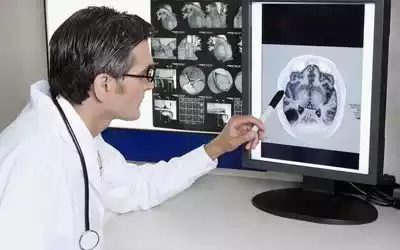Ice Pick and Thunderclap Headache are two distinct types of severe headache disorders with contrasting characteristics. Ice Pick Headaches are known for their sudden, stabbing pain that typically lasts for seconds to minutes, often occurring multiple times a day.
Thunderclap Headaches are characterized by an intense, sudden-onset, excruciating pain that can last for hours to days, sometimes described as the worst headache one has ever experienced. Understanding the differences between these two types of headaches is crucial for proper diagnosis and timely medical intervention, particularly in the case of Thunderclap Headaches, which can be associated with serious underlying conditions.
Ice Pick Headache

An ice pick headache, also known as “jabs and jolts headache” or “primary stabbing headache,” is a type of headache characterized by sudden, sharp, and stabbing pain, often occurring in brief and intense episodes. These headaches typically manifest as severe, localized pain, frequently felt around the eye or temple area, and they can occur repeatedly throughout the day.
Ice pick headaches are known for their short duration, usually lasting for a few seconds to a couple of minutes, and they do not typically lead to other neurological symptoms. While their exact cause is not always clear, they are considered a primary headache disorder and are not usually associated with underlying structural issues or serious medical conditions.
Characteristics of Ice Pick Headache
Characteristics of Ice Pick Headache:
- Sudden and sharp stabbing pain
- Brief duration, typically lasting seconds to minutes
- Often occurs multiple times a day
- Typically localized around the eye or temple
- Not usually associated with other neurological symptoms
- Often idiopathic or related to primary headache disorders
Causes of Ice Pick Headache
The exact causes of ice pick headaches are not always clear, and they can vary among individuals. Ice pick headaches are often considered primary headache disorders, meaning they occur on their own without an underlying medical condition.
Potential contributing factors and triggers can include:
-
- Idiopathic: In many cases, the cause of ice pick headaches remains unknown, and they are referred to as idiopathic.
- Primary Headache Disorders: Ice pick headaches can be associated with primary headache disorders such as cluster headaches or migraine. They may occur as a part of these headache syndromes.
- Triggers: Some people may notice that certain triggers, such as stress, alcohol, or certain foods, can provoke ice pick headaches.
- Neurovascular Factors: There is some evidence to suggest that changes in blood vessels or the nerves around the head may contribute to ice pick headaches, but this is not well understood.
- Medications: In rare cases, certain medications may lead to ice pick headaches as a side effect.
- Other Factors: Some individuals may experience ice pick headaches as a result of other factors, including head trauma or sinus problems, though these are less common.
While ice pick headaches are usually benign, they should be evaluated by a healthcare professional to rule out other potential causes and to determine the most appropriate treatment or management strategy.
Diagnosis of Ice Pick Headache
The diagnosis of ice pick headache is primarily clinical, based on a thorough evaluation of the patient’s medical history and the characteristic features of the headaches. Here is an overview of the diagnostic process for ice pick headaches:
- Medical History: The healthcare provider will conduct a detailed medical history interview with the patient, focusing on the description of headache symptoms, including the location, duration, frequency, and quality of the pain. They will also inquire about any potential triggers or patterns associated with the headaches.
- Physical Examination: A physical examination is performed to assess the patient’s overall health and to rule out any signs of other underlying medical conditions that might be causing the headaches.
- Differential Diagnosis: The healthcare provider will consider various other headache disorders and medical conditions that can cause similar symptoms and attempt to differentiate ice pick headaches from these conditions. This may include conditions such as cluster headaches, migraine, or trigeminal neuralgia.
- Imaging Studies: In most cases, imaging studies like CT scans or MRIs are not necessary to diagnose ice pick headaches, as they are typically used to rule out more serious underlying causes when there are atypical features or neurological symptoms. However, if there are specific concerns or unusual symptoms, imaging may be recommended to ensure there are no structural abnormalities.
- Response to Treatment: Treating headaches caused by ice may further validate its diagnosis. Common treatments include pain relief medications and lifestyle modifications.
- Diagnostic Criteria: The diagnosis may also be based on established diagnostic criteria for primary stabbing headache or ice pick headache, as defined by medical classification systems such as the International Classification of Headache Disorders (ICHD).
It’s important for individuals experiencing ice pick headaches to consult with a healthcare professional for an accurate diagnosis and to discuss appropriate treatment options. While ice pick headaches are generally considered benign, it’s essential to rule out other potential causes and to manage the condition effectively to improve the patient’s quality of life.
Thunderclap Headache

A thunderclap headache is an extremely severe and sudden-onset headache characterized by an abrupt and intense pain that reaches its peak within a minute or less. These headaches are often described as the most excruciating headache one has ever experienced and are sometimes referred to as “the worst headache of my life.” Thunderclap headaches are typically generalized, meaning they affect the entire head rather than being localized to a specific area.
These headaches can last for hours to days and are associated with various underlying causes, including serious medical conditions such as bleeding in the brain, vascular issues, or infections. Due to the potential seriousness of the underlying causes, prompt medical evaluation and intervention are crucial when someone experiences a thunderclap headache.
Characteristics of Thunderclap
Characteristics of Thunderclap Headache:
- Sudden and extremely severe onset of pain
- Peaks within a minute or less
- Described as “worst headache of my life”
- Generalized, affecting the entire head
- Can last for hours to days
- Often associated with serious underlying medical conditions
- May be accompanied by other neurological symptoms
- Requires immediate medical evaluation and intervention
Causes of Thunderclap Headache
Thunderclap headaches can be caused by a variety of underlying medical conditions and triggers. It’s crucial to identify the cause promptly because some of these conditions are serious and require immediate medical attention.
Common causes of thunderclap headaches include:
-
- Subarachnoid Hemorrhage: A rupture of a blood vessel in the brain can lead to bleeding into the space surrounding the brain, causing sudden and severe headaches.
- Intracerebral Hemorrhage: Bleeding within the brain tissue itself, often due to a ruptured blood vessel or an aneurysm, can result in thunderclap headaches.
- Cerebral Venous Sinus Thrombosis: Blood clotting in the brain’s venous sinuses can lead to increased intracranial pressure and severe headaches.
- Migraine: While migraine headaches are typically not associated with thunderclap characteristics, some people with a history of migraines may experience severe, sudden-onset headaches that mimic thunderclap headaches.
- Reversible Cerebral Vasoconstriction Syndrome (RCVS): RCVS is characterized by the sudden narrowing of blood vessels in the brain, leading to intense headaches.
- Ischemic Stroke: A blockage in a blood vessel in the brain can lead to insufficient blood supply and severe headaches.
- Hypertensive Crisis: Extremely high blood pressure can cause severe headaches, but this usually occurs with other symptoms such as visual disturbances and confusion.
- Intracranial Aneurysm: An aneurysm that ruptures or leaks can result in a sudden, severe headache.
- Primary Thunderclap Headache: In some cases, thunderclap headaches may have no identifiable underlying cause and are classified as a primary headache disorder.
- Medications and Illicit Drugs: Certain medications, such as triptans or amphetamines, and the use of illicit drugs like cocaine can trigger thunderclap headaches.
- Infections: Infections in the brain, such as encephalitis or meningitis, can cause sudden, severe headaches.
- Post-Coital Headache: Some individuals may experience sudden-onset headaches during or after sexual activity.
Due to the potentially life-threatening causes of thunderclap headaches, it is crucial for individuals experiencing such headaches to seek immediate medical evaluation and intervention. A thorough medical evaluation, including neuroimaging (e.g., CT scan or MRI), is often necessary to determine the precise cause and appropriate treatment.
Diagnosis of Thunderclap Headache
Diagnosing a thunderclap headache involves a comprehensive medical evaluation to identify its underlying cause, as these headaches can be associated with serious medical conditions.
Diagnostic steps typically include these elements:
- Clinical Assessment: A healthcare provider will conduct a thorough medical history interview with the patient. They will inquire about the onset, duration, location, and quality of the headache pain, as well as any associated symptoms or triggers. It’s important for the patient to describe the headache’s intensity accurately, especially if they use phrases like “worst headache of my life.”
- Physical Examination: A physical examination is performed to assess the patient’s overall health and neurological status. The healthcare provider will check for signs of neurological deficits or other abnormalities that may provide clues about the underlying cause.
- Neuroimaging: Imaging studies, such as a CT (computed tomography) scan or MRI (magnetic resonance imaging) of the brain, are typically ordered to identify any structural abnormalities, bleeding, or other abnormalities in the brain. These scans can help rule out conditions like subarachnoid hemorrhage, ischemic stroke, or intracerebral hemorrhage.
- Lumbar Puncture (Spinal Tap): In cases where subarachnoid hemorrhage is suspected but not detected on initial imaging, a lumbar puncture may be performed to analyze the cerebrospinal fluid for signs of bleeding or infection.
- Blood Tests: Blood tests may be ordered to assess various parameters, including complete blood count (CBC), electrolyte levels, coagulation profile, and inflammatory markers, depending on the suspected cause.
- Medical History and Risk Factors: The healthcare provider will also consider the patient’s medical history and risk factors for specific conditions, such as a history of hypertension, use of medications, recent sexual activity (in the case of post-coital headaches), or any history of vascular or neurological conditions.
- Differential Diagnosis: The healthcare provider will rule out other causes of sudden and severe headaches, such as migraine, tension-type headache, and secondary headaches caused by infections, medication side effects, or other factors.
- Consultation with Specialists: Depending on the findings and suspected cause, consultation with neurologists, neurosurgeons, or other specialists may be necessary to provide expertise and guidance in diagnosing and managing thunderclap headaches.
Prompt and accurate diagnosis is essential for thunderclap headaches because they can be associated with life-threatening conditions. Once the underlying cause is determined, appropriate treatment and management strategies can be initiated to address the specific condition and alleviate symptoms.
Comparison Table of Ice Pick and Thunderclap Headache
Here’s a comparison table highlighting the key differences between ice pick headaches and thunderclap headaches:
| Characteristic | Ice Pick Headache | Thunderclap Headache |
|---|---|---|
| Pain Type | Sudden, stabbing, and sharp pain | Sudden, extremely severe, intense |
| Duration | Seconds to minutes | Hours to days |
| Frequency | Multiple times a day | Can be a single episode or recurrent |
| Location | Typically around the eye or temple | Generalized, affecting the whole head |
| Triggers and Causes | Often idiopathic or related to primary headache disorders | Often associated with serious underlying medical conditions |
| Neurological Symptoms | Typically none | May be accompanied by other neurological symptoms |
| Diagnostic Imaging | Usually not required | Typically requires CT scan or MRI |
| Response to Treatment | Typically responsive to pain relief medications and lifestyle modifications | Requires addressing the underlying cause |
| Management | Pain relief medications, lifestyle modifications, preventive measures | Address underlying medical condition, symptomatic relief |
| Urgency of Evaluation | Usually not immediately urgent | Requires immediate medical evaluation due to potential serious causes |
| Common Conditions | Primary stabbing headache, primary headache disorders | Subarachnoid hemorrhage, intracerebral hemorrhage, migraine with thunderclap features, cerebral venous sinus thrombosis, etc. |
It’s essential to differentiate between these two types of headaches due to their distinct characteristics and potential underlying causes. While ice pick headaches are often benign and primarily managed with pain relief measures, thunderclap headaches demand urgent medical attention and thorough evaluation to identify and address the underlying medical condition.
Treatment options for Ice Pick and Thunderclap Headache
Treatment options for ice pick headaches and thunderclap headaches differ significantly due to their distinct characteristics and underlying causes. Here are the treatment approaches for each:
Treatment for Ice Pick Headache
- Pain Relief Medications:
- Over-the-counter pain relievers like ibuprofen or naproxen sodium may provide relief during an episode.
- Prescription medications, such as indomethacin, may be recommended for more severe or frequent ice pick headaches.
- Lifestyle Modifications:
- Identifying and avoiding triggers, if known.
- Maintaining regular sleep patterns and managing stress, as these factors can influence the frequency of headaches.
- Preventive Measures:
- In cases of frequent and severe ice pick headaches, a healthcare provider may prescribe preventive medications, such as certain antiepileptic drugs (e.g., topiramate) or tricyclic antidepressants (e.g., amitriptyline).
Treatment for Thunderclap Headache
Treatment for thunderclap headaches is primarily focused on addressing the underlying cause, which may be a medical emergency. It’s essential to seek immediate medical attention in cases of thunderclap headaches. Treatment options can include:
- Emergency Care:
- Hospitalization is often required for a comprehensive evaluation.
- Neuroimaging, such as a CT scan or MRI, will be performed to identify the cause.
- Intravenous fluids and medications to manage symptoms and reduce intracranial pressure may be administered.
- Management of Specific Causes:
- The treatment approach will depend on the underlying cause:
- Subarachnoid Hemorrhage: Surgical intervention may be necessary to repair the bleeding blood vessel.
- Ischemic Stroke: Thrombolytic therapy or clot retrieval procedures may be employed.
- Cerebral Venous Sinus Thrombosis: Anticoagulant therapy to dissolve blood clots may be initiated.
- Migraine with Thunderclap Features: Treatment may include migraine-specific medications, lifestyle modifications, and prevention strategies.
- The treatment approach will depend on the underlying cause:
- Secondary Prevention: After addressing the acute issue, healthcare providers may recommend measures to prevent recurrence, such as managing blood pressure, lifestyle changes, or medication for certain conditions.
Ice pick headaches are usually managed with pain relief medications and lifestyle adjustments, while thunderclap headaches demand immediate medical evaluation and intervention to identify and address the underlying cause. Prompt diagnosis and appropriate treatment are critical for thunderclap headaches, as they can be associated with life-threatening conditions.
When to Seek Medical Help

Ice pick and thunderclap headaches are known for their sudden and intense nature. While not all headaches require immediate medical attention, there are specific situations in which you should seek medical help promptly. Recognizing when to take action can be critical to your health and well-being.
Here are some guidelines to help you determine when to seek medical help for ice pick and thunderclap headaches:
- Sudden and Severe Onset: If you experience a headache that comes on suddenly and with extreme intensity, resembling a thunderclap, do not ignore it. Seek medical attention immediately. Thunderclap headaches can be a sign of serious underlying conditions, such as bleeding in the brain or a ruptured aneurysm.
- Neurological Symptoms: If your headache is accompanied by neurological symptoms such as slurred speech, numbness or weakness in your limbs, confusion, or loss of consciousness, it’s crucial to seek immediate medical help. These symptoms could indicate a medical emergency, and quick intervention is essential.
- Change in Headache Pattern: If you have a history of ice pick or thunderclap headaches, but you notice a significant change in their frequency, intensity, or characteristics, consult a healthcare professional. Any unusual or persistent changes warrant a medical evaluation.
- Pain Lasting More Than 72 Hours: While ice pick headaches are typically short-lived, if you experience a headache that persists for more than 72 hours, it’s time to consult a doctor. Chronic headaches may require a different approach to diagnosis and treatment.
- Worsening Symptoms: If your headache symptoms worsen over time or become more frequent and debilitating, it’s essential to have a medical assessment. These changes could signal an underlying issue that needs attention.
- Headache After Head Injury: If you have experienced a head injury, even a minor one, and subsequently develop a headache, consult a healthcare provider. Head injuries can sometimes lead to complications, and a medical evaluation is necessary to rule out any serious conditions.
- Headache Accompanied by Fever: If you have a headache along with a fever, it could indicate an infection or other underlying medical problem. Consult a medical expert in order to identify the source and treatments suitable.
- Headache in a New Location: If you’ve never experienced headaches before and suddenly have one, it’s important to see a doctor. New-onset headaches should be evaluated to rule out any underlying issues.
- Concerns About Medication Side Effects: If you are taking medication for your headaches and are worried about potential side effects or if the medication doesn’t seem to be helping, consult your healthcare provider. They can adapt the treatment plan if necessary.
- Other Unusual Symptoms: Pay attention to any other unusual symptoms accompanying your headaches, such as changes in vision, difficulty swallowing, or neck stiffness. These signs should not be disregarded and should be discussed with a healthcare provider immediately.
While not all ice pick and thunderclap headaches are cause for immediate concern, it’s essential to be vigilant about changes in your headache patterns, intensity, or associated symptoms. When in doubt, err on the side of caution and seek medical help. Timely evaluation and treatment can make a significant difference in managing these types of headaches and addressing any underlying medical conditions. Your health and wellbeing must always take precedence.
Final Opinion
Ice Pick and Thunderclap Headaches are two distinct types of headaches known for their sudden and severe nature. While they can be challenging to manage, timely medical attention, proper diagnosis, and a proactive approach to lifestyle adjustments can significantly improve one’s quality of life. Remember, if you ever experience unusual or severe headache symptoms, it’s essential to consult a healthcare professional for guidance and appropriate treatment.



